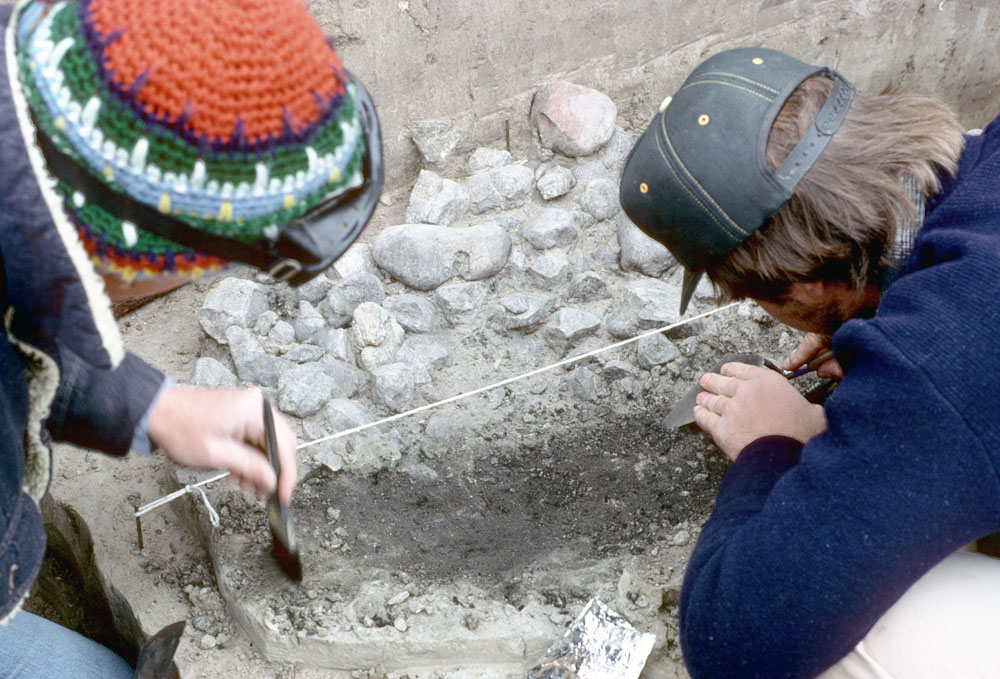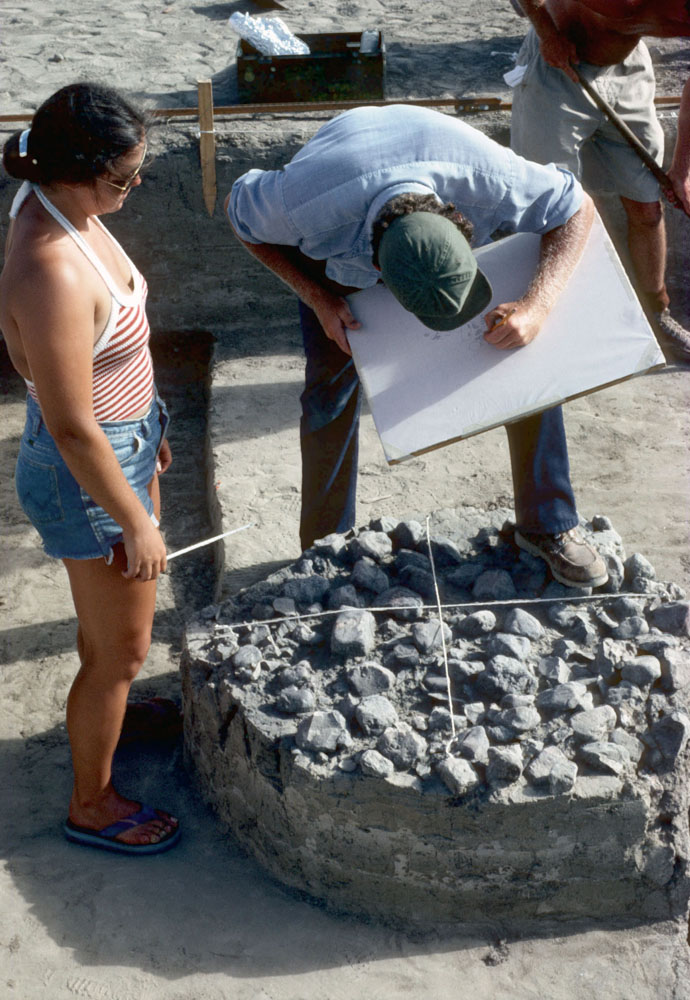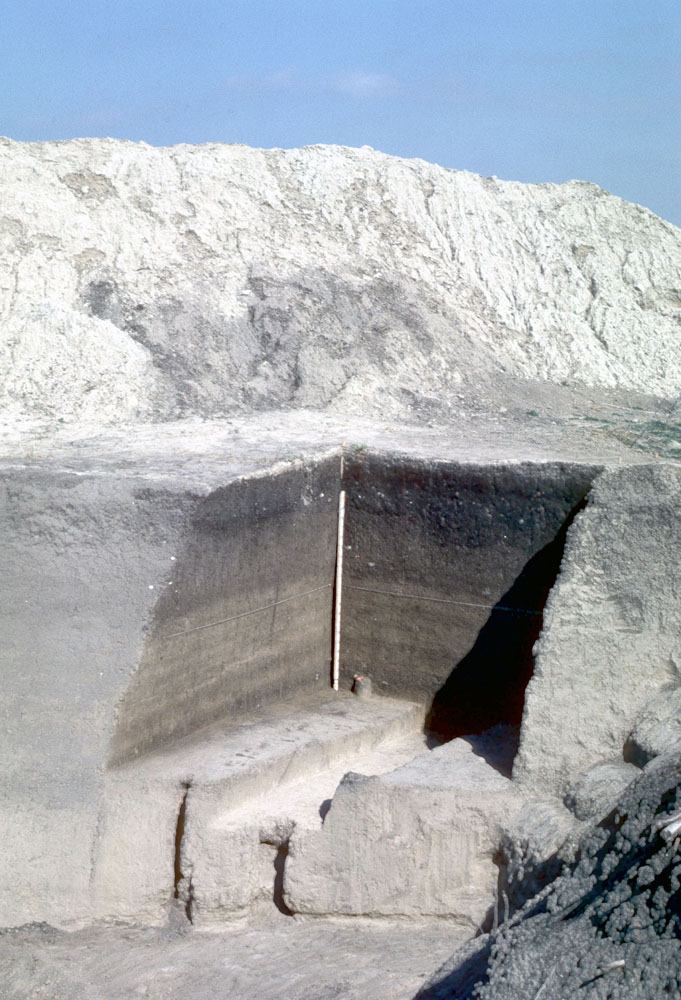|
The Gates-Rowell site offered archeologists an exceptional opportunity for studying the activities of
prehistoric people because of the past frequency with which the Frio River flooded and covered ancient
camp site debris with sediment. These layers of sediment laid down between camping episodes served to "
freeze" evidence of past human activity in place, so to speak. An excellent example of such preservation
is shown in this feature, consisting of some chert cobbles and flakes that had been left behind by a
prehistoric flintknapper in the process of making some stone tools. Right next to the chert tool-making
debris was a cluster of mussel shells. This feature was covered by flood sediment shortly after
the flintknapper sat making tools and dining on a meal of mussels.
At many open prehistoric camp sites, such debris would have been disturbed and scattered before being
buried, and thus would not provide as clear a "snapshot" of ancient life as was provided at
Gates-Rowell.
Open camp fires, dating back to the Middle Archaic period (as much as 5,000 years ago) were places
where people cooked some of the foods that sustained them. One such example from the Gates-Rowell site
was marked by fired clay and small amounts of charcoal in the midst of numerous mussel shells and the
shells of big land snails (referred to by archeologists using the scientific name Rabdotus). The mussels
were probably gathered from shallow water in the channel of the Frio River. The gastropod land snails,
common over all of the South Texas Plains, can be easily collected on land. Both the mussels and snails, being easy
to gather, would be good food resources for children to go out and collect as their contribution to family
meals back in camp. To prepare mussels and snails for eating, it was necessary only to build a small
ground fire and place the mussels and snails, still in their shells, on the coals and embers for just a few minutes. Once
cooked, the snail or mussel was easily removed from the shell.
These hearths usually consisted of a shallow pit dug into the ground. A wood fire was built in the pit
and then a layer of river cobbles was placed on top of the fire to absorb the heat. Food products, such
as fish, rabbits, or venison could then be cooked on top of the rocks, using them like a griddle.
Charcoal (carbonized wood) found in such features was very useful for two reasons. First, the carbon
could be submitted for radiocarbon dates, allowing a determination of how long ago people
created the feature and were living on the site. Secondly, in the hands of an expert, the species of wood
burned to form the charcoal can sometimes be determined. Carbon samples from hearths at the Gates-Rowell
site were identified as being oak and ash by Dr. Phil Dering of Texas A&M University. Thus, archeologists
knew not only when the hearths were built, but what woods were used as fuel.
Artifacts recovered during excavations at the site are typical of Archaic sites in the region. Chipped stone dart points, gouges, and bifacial chipped stone knife blades are
included in the assemblage. Also recovered were flakes and chips of chert, much of them simply being
waste products from the manufacture of stone tools, known in flintknapping jargon as "debitage." Some of
these flakes and chips, however, were used very effectively in a variety of cutting and scraping chores
that occurred every day in the camps.
Other debris commonly recovered in excavations includes burned- and fire-fractured rock, mussel shells,
and snail shells. Though small numbers of animal bones were recovered, the preservation of bone was
generally very poor. One type of fish bone, known as an "otolith," did survive at the Gates-Rowell site,
probably because such bones, being particularly thick and shaped like lima beans, were more durable than
the thin bones typical of many animals. It is probable that the archeological deposits
preserved only a fraction of the bones of animals that were brought to the site to eat. No direct
evidence of the plant foods the people used was recovered, but such food must have been a big contributor
to the diet of the prehistoric people at Gates-Rowell.
|

Archeologists Curtis Dusek and Dan Potter excavating a cross-section through this nice pit-hearth feature at the Gates-Rowell site.  |

Relatively few "diagnostic" or time-marker artifacts such as these dart points, knives, and gouges, were recovered from the Gates-Rowell site. These artifacts are Early and Middle Archaic in age, time periods very poorly known in the region.  |

Clusters of mussel shells and burned rocks at the Gates-Rowell site are evidence of places where what we might call "quick dinners" were prepared.  |

Archeologists document a peculiar feature, a shallow basin where stream cobbles made of chert were heated, presumably as the heating element of an earth oven. This is peculiar, because chert cobbles are very poorly suited for safe cooking--they tend to explode when placed in a hot fire, sending hot pieces of glass-like chert shooting out. We know this because of inadvertent "experiments" done by naive archeologists.  |
|








